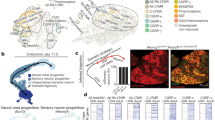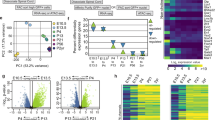Abstract
The organization of neurons into columns is a prominent feature of central nervous system structure and function. In many regions of the central nervous system the grouping of neurons into columns links cell-body position to axonal trajectory, thus contributing to the establishment of topographic neural maps. This link is prominent in the developing spinal cord, where columnar sets of motor neurons innervate distinct targets in the periphery. We show here that sequential phases of Hox-c protein expression and activity control the columnar differentiation of spinal motor neurons. Hox expression in neural progenitors is established by graded fibroblast growth factor signalling and translated into a distinct motor neuron Hox pattern. Motor neuron columnar fate then emerges through cell autonomous repressor and activator functions of Hox proteins. Hox proteins also direct the expression of genes that establish motor topographic projections, thus implicating Hox proteins as critical determinants of spinal motor neuron identity and organization.
This is a preview of subscription content, access via your institution
Access options
Subscribe to this journal
Receive 51 print issues and online access
$199.00 per year
only $3.90 per issue
Buy this article
- Purchase on Springer Link
- Instant access to full article PDF
Prices may be subject to local taxes which are calculated during checkout







Similar content being viewed by others
References
Mountcastle, V. B. The columnar organization of the neocortex. Brain 120, 701–722 (1997)
Sanders, T. A., Lumsden, A. & Ragsdale, C. W. Arcuate plan of chick midbrain development. J. Neurosci. 22, 10742–10750 (2002)
Jessell, T. M. Neuronal specification in the spinal cord: inductive signals and transcriptional codes. Nature Rev. Genet. 1, 20–29 (2000)
Briscoe, J. & Ericson, J. Specification of neuronal fates in the ventral neural tube. Curr. Opin. Neurobiol. 11, 43–49 (2001)
Landmesser, L. The distribution of motoneurones supplying chick hind limb muscles. J. Physiol. (Lond.) 284, 371–389 (1978)
Hollyday, M. Organization of motor pools in the chick lumbar lateral motor column. J. Comp. Neurol. 194, 143–170 (1980)
Hollyday, M. Motoneuron histogenesis and the development of limb innervation. Curr. Top. Dev. Biol. 15, 181–215 (1980)
Gutman, C. R., Ajmera, M. K. & Hollyday, M. Organization of motor pools supplying axial muscles in the chicken. Brain Res. 609, 129–136 (1993)
Shirasaki, R. & Pfaff, S. L. Transcriptional codes and the control of neuronal identity. Annu. Rev. Neurosci. 25, 251–281 (2002)
Ensini, M., Tsuchida, T. N., Belting, H. G. & Jessell, T. M. The control of rostrocaudal pattern in the developing spinal cord: specification of motor neuron subtype identity is initiated by signals from paraxial mesoderm. Development 125, 969–982 (1998)
Liu, J. P., Laufer, E. & Jessell, T. M. Assigning the positional identity of spinal motor neurons: rostrocaudal patterning of Hox-c expression by FGFs, Gdf11, and retinoids. Neuron 32, 997–1012 (2001)
Bel-Vialar, S., Itasaki, N. & Krumlauf, R. Initiating Hox gene expression: in the early chick neural tube differential sensitivity to FGF and RA signaling subdivides the HoxB genes in two distinct groups. Development 129, 5103–5115 (2002)
Studer, M., Lumsden, A., Ariza-McNaughton, L., Bradley, A. & Krumlauf, R. Altered segmental identity and abnormal migration of motor neurons in mice lacking Hoxb-1. Nature 384, 630–634 (1996)
Bell, E., Wingate, R. J. & Lumsden, A. Homeotic transformation of rhombomere identity after localized Hoxb1 misexpression. Science 284, 2168–2171 (1999)
Rossel, M. & Capecchi, M. R. Mice mutant for both Hoxa1 and Hoxb1 show extensive remodeling of the hindbrain and defects in craniofacial development. Development 126, 5027–5040 (1999)
Prasad, A. & Hollyday, M. Development and migration of avian sympathetic preganglionic neurons. J. Comp. Neurol. 307, 237–258 (1991)
Tsuchida, T. et al. Topographic organization of embryonic motor neurons defined by expression of LIM homeobox genes. Cell 79, 957–970 (1994)
William, C. M., Tanabe, Y. & Jessell, T. M. Regulation of motor neuron subtype identity by repressor activity of Mnx class homeodomain proteins. Development 130, 1523–1536 (2003)
Niederreither, K., McCaffery, P., Drager, U. C., Chambon, P. & Dolle, P. Restricted expression and retinoic acid-induced downregulation of the retinaldehyde dehydrogenase type 2 (RALDH-2) gene during mouse development. Mech. Dev. 62, 67–78 (1997)
Sockanathan, S. & Jessell, T. M. Motor neuron-derived retinoid signaling specifies the subtype identity of spinal motor neurons. Cell 94, 503–514 (1998)
Hart, K. C. et al. Transformation and Stat activation by derivatives of FGFR1, FGFR3, and FGFR4. Oncogene 19, 3309–3320 (2000)
Gabay, L., Seger, R. & Shilo, B. Z. MAP kinase in situ activation atlas during Drosophila embryogenesis. Development 124, 3535–3541 (1997)
Cai, J. et al. Evidence for the differential regulation of Nkx-6.1 expression in the ventral spinal cord and foregut by Shh-dependent and -independent mechanisms. Genesis 27, 6–11 (2000)
Arber, S. et al. Requirement for the homeobox gene Hb9 in the consolidation of motor neuron identity. Neuron 23, 659–674 (1999)
Jaynes, J. B. & O'Farrell, P. H. Active repression of transcription by the engrailed homeodomain protein. EMBO J. 10, 1427–1433 (1991)
Sockanathan, S., Perlmann, T. & Jessell, T. M. Retinoid receptor signaling in postmitotic motor neurons regulates rostrocaudal positional identity and axonal projection pattern. Neuron 40, 97–111 (2003)
Kostic, D. & Capecchi, M. R. Targeted disruptions of the murine Hoxa-4 and Hoxa-6 genes result in homeotic transformations of components of the vertebral column. Mech. Dev. 46, 231–247 (1994)
Garcia-Gasca, A. & Spyropoulos, D. D. Differential mammary morphogenesis along the anteroposterior axis in Hoxc6 gene targeted mice. Dev. Dyn. 219, 261–276 (2000)
Chen, F. & Capecchi, M. R. Hoxa9, Hoxb9, and Hoxd9, function together to control development of the mammary gland in response to pregnancy. Proc. Natl Acad. Sci. USA 96, 541–546 (1999)
Suemori, H. & Noguchi, S. Hox C cluster genes are dispensable for overall body plan of mouse embryonic development. Dev. Biol. 220, 333–342 (2000)
Lance-Jones, C., Omelchenko, N., Bailis, A., Lynch, S. & Sharma, K. Hoxd10 induction and regionalization in the developing lumbosacral spinal cord. Development 128, 2255–2268 (2001)
Carpenter, E. M. Hox genes and spinal cord development. Dev. Neurosci. 24, 24–34 (2002)
Briscoe, J., Pierani, A., Jessell, T. M. & Ericson, J. A homeodomain protein code specifies progenitor cell identity and neuronal fate in the ventral neural tube. Cell 101, 435–445 (2000)
Muhr, J., Andersson, E., Persson, M., Jessell, T. M. & Ericson, J. Groucho-mediated transcriptional repression establishes progenitor cell pattern and neuronal fate in the ventral neural tube. Cell 104, 861–873 (2001)
Goddard, J. M., Rossel, M., Manley, N. R. & Capecchi, M. R. Mice with targeted disruption of Hoxb-1 fail to form the motor nucleus of the VIIth nerve. Development 122, 3217–3228 (1996)
Cooper, K. L., Leisenring, W. M. & Moens, C. B. Autonomous and nonautonomous functions for Hox/Pbx in branchiomotor neuron development. Dev. Biol. 253, 200–213 (2003)
Duboule, D. & Morata, G. Colinearity and functional hierarchy among genes of the homeotic complexes. Trends Genet. 10, 358–364 (1994)
Kmita, M. & Duboule, D. Organizing axes in time and space; 25 years of colinear tinkering. Science 301, 331–333 (2003)
Jegalian, B. G. & De Robertis, E. M. Homeotic transformations in the mouse induced by overexpression of a human Hox3.3 transgene. Cell 71, 901–910 (1992)
Cohn, M. J., Izpisua-Belmonte, J. C., Abud, H., Heath, J. K. & Tickle, C. Fibroblast growth factors induce additional limb development from the flank of chick embryos. Cell 80, 739–746 (1995)
Cohn, M. J. et al. Hox9 genes and vertebrate limb specification. Nature 387, 97–101 (1997)
Kania, A. & Jessell, T. M. Topographic motor projections in the limb imposed by LIM homeodomain protein regulation of ephrin-A:EphA interactions. Neuron 38, 581–596 (2003)
Hollyday, M. & Jacobson, R. D. Location of motor pools innervating chick wing. J. Comp. Neurol. 302, 575–588 (1990)
Wahba, G. M., Hostikka, S. L. & Carpenter, E. M. The paralogous Hox genes Hoxa10 and Hoxd10 interact to pattern the mouse hindlimb peripheral nervous system and skeleton. Dev. Biol. 231, 87–102 (2001)
Tiret, L., Le Mouellic, H., Maury, M. & Brulet, P. Increased apoptosis of motoneurons and altered somatotopic maps in the brachial spinal cord of Hoxc-8-deficient mice. Development 125, 279–291 (1998)
Mann, R. S. & Affolter, M. Hox proteins meet more partners. Curr. Opin. Genet. Dev. 8, 423–429 (1998)
Nelson, C. E. et al. Analysis of Hox gene expression in the chick limb bud. Development 122, 1449–1466 (1996)
Brend, T., Gilthorpe, J., Summerbell, D. & Rigby, P. W. Multiple levels of transcriptional and post-transcriptional regulation are required to define the domain of Hoxb4 expression. Development 130, 2717–2728 (2003)
Li, X. & McGinnis, W. Activity regulation of Hox proteins, a mechanism for altering functional specificity in development and evolution. Proc. Natl Acad. Sci. USA 96, 6802–6807 (1999)
Acknowledgements
We thank F. Lo for technical assistance; C. Tabin for chick Hox in situ probes; and E. Laufer for advice and critical reagents. We thank R. Axel, J. DeNooij, J. Ericson, E. Laufer, R. Mann, B. Novitch and S. Wilson for comments, and K. MacArthur for help in preparing the manuscript. J.-P.L. is supported by a grant from NINDS and is a recipient of a Burroughs Wellcome Fund Career Award in Biomedical Sciences. J.D. is a research associate and T.M.J. an investigator of the Howard Hughes Medical Institute.
Author information
Authors and Affiliations
Corresponding authors
Ethics declarations
Competing interests
The authors declare that they have no competing financial interests.
Supplementary information
Rights and permissions
About this article
Cite this article
Dasen, J., Liu, JP. & Jessell, T. Motor neuron columnar fate imposed by sequential phases of Hox-c activity. Nature 425, 926–933 (2003). https://doi.org/10.1038/nature02051
Received:
Accepted:
Issue Date:
DOI: https://doi.org/10.1038/nature02051
This article is cited by
-
BAF45D-binding to HOX genes was differentially targeted in H9-derived spinal cord neural stem cells
Scientific Reports (2024)
-
Generation of human iPSC-derived phrenic-like motor neurons to model respiratory motor neuron degeneration in ALS
Communications Biology (2024)
-
Efficient generation of a self-organizing neuromuscular junction model from human pluripotent stem cells
Nature Communications (2023)
-
MiR-615 Agomir Encapsulated in Pluronic F-127 Alleviates Neuron Damage and Facilitates Function Recovery After Brachial Plexus Avulsion
Journal of Molecular Neuroscience (2022)
-
Generation of extracellular morphogen gradients: the case for diffusion
Nature Reviews Genetics (2021)
Comments
By submitting a comment you agree to abide by our Terms and Community Guidelines. If you find something abusive or that does not comply with our terms or guidelines please flag it as inappropriate.



